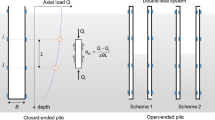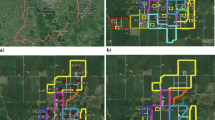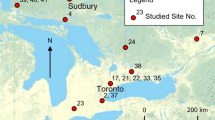Abstract
This paper presents the results from a pile load testing program for a bridge construction project in Louisiana. The testing includes two 54-in. open-ended spun cast concrete cylinder piles, one 30-in. open-ended steel pile and two (30- and 16-in.) square prestressed concrete (PSC) piles driven at two locations with very similar soil conditions. Both cone penetration tests (CPTs) and soil borings/laboratory testing were used to characterize the subsurface soil conditions. All the test piles were instrumented with vibrating wire strain gauges to measure the load distribution along the length of the test piles and measure the skin friction and end-bearing capacity, separately. Dynamic load tests were performed on all test piles at different times after pile installations to quantify the amount of setup with time. Static load tests were also performed on the PSC and open-ended steel piles. Due to expected large pile capacities, the statnamic test method was used on the two open-ended cylinder piles. The pile capacities of these piles were evaluated using various CPT methods (such as Schmertmann, De Ruiter and Beringen, LCPC, Lehane et al. methods). The result showed that all the methods can estimate the skin friction with good accuracy, but not the end-bearing capacity. The normalized cumulative blow counts during pile installation showed that the blow count was always higher for the PSC piles compared to the large-diameter open-ended cylinder pile, regardless of pile size and hammer size. Setup was observed for all the piles, which was mainly attributed to increase in skin frictions. The setup parameters “A” were back-calculated for all the test piles and the values were between 0.31 and 0.41.








Similar content being viewed by others
References
Abu-Farsakh MY, Rosti F, Souri A (2015) Evaluating pile installation and subsequent thixotropic and consolidation effects on setup by numerical simulation for full scale pile load tests. Can Geotech J. doi:10.1139/cgj-2014-0470
Abu-Farsakh MY, Titi HH (2004) Assessment of direct cone penetration test methods for predicting the ultimate capacity of friction driven piles. J Geotech Geoenviron Eng 130(9):935–944
Abu-Farsakh MY, Titi HH (2007) Probabilistic CPT method for estimating the ultimate capacity of friction piles. Geotech Test J 30(5):1–15
Abu-Farsakh M (2004) Evaluation of consolidation characteristics of cohesive soils from piezocone penetration tests. Report No. FHWA/LA.03/386, Louisiana Transportation Research Center, Baton Rouge, LA
Axelsson G (2000) Long term set-up of piles in sand. Doctoral thesis. Royal Institute of Technology, Stockholm
Briaud JL, Tucker LM (1988) Measured and predicted axial response of 98 piles. J Geotech Eng 114(8):984–1001
Bullock PJ, Schmertmann JH, McVay MC, Townsend FC (2005) Side shear setup I: test piles driven in Florida. J Geotech Geoenviron Eng 131(3):292–300
Bustamante M, Gianeselli L (1982) Pile bearing capacity predictions by means of static penetrometer CPT. In: Proceedings to 2nd European symposium on penetration testing, ESOPTII, Amsterdam, pp 493–500
Chen Q, Haque M, Abu-Farsakh M, Fernandez BA (2014) Field investigation of pile set-up in mixed soil. Geotech Test J 37(2):268–281
Chow FC, Jardine RJ, Nauroy JF, Brucy F (1997) Time related increase in shaft capacities of driven piles in sand. Geotechnique 47(2):353–361
Chow FC, Jardine RJ, Brucy F, Nauroy JF (1998) Effects of time on capacity of pipe piles in dense Marine sand. J Geotech Geoenviron Eng 124(3):254–264
De Ruiter J, Beringen FL (1979) Pile foundations for large North Sea structures. Mar Geotechnol 3(3):267–314
Doherty P, Gavin K (2011) Shaft capacity of open-ended piles in clay. J Geotech Geoenviron Eng 137(11):1090–1102
Eslami A, Fellenius BH (1997) Pile capacity by direct CPT and CPTU methods applied to 102 case histories. Can Geotech J 34:886–904
Eslami A, Fellenius BH (1995) Toe bearing capacity of piles from cone penetration (CPT) test. In: Proceedings to international symposium on cone penetration testing (CPT’95), Sweden, October 4–5
Fawad SN, Paul WM (2013) Cone penetration test based direct methods for evaluating static axial capacity of single piles. Geotech Geol Eng 31(4):979–1009
Fellinius BH (2008) Effective stress analysis and set-up for shaft capacity of piles in clay. In: Proceedings to from research to practice in geotechnical engineering, Geo-Institute of the American Society of Civil Engineering, Alberta, Canada, pp 384–406
Fellenius BH (2015) The response of a “plug” in an open-toe pile. Geotech Eng J SEAGS AGSSEA 46(2):82–86
Fugro. Axial pile capacity design methods for offshore driven piles in sand. Report to the American Petroleum Institute, P-1003, Issue
Haque MN, Abu-Farsakh M, Chen Q (2015) Pile set-up for individual soil layers along instrumented test piles in clayey soil. In: Manzanal D, Sfriso AO (eds) Proceedings of the 15th Pan-American conference on soil mechanics and geotechnical engineering (from fundamentals to applications in geotechnics), 15–18 November. IOS Press, Buenos Aires, Argentina, pp 390–397
Haque MN, Abu-Farsakh M, Chen Q, Zhang Z (2014) Case study on instrumenting and testing full scale test piles for evaluating set-up phenomenon. J Transp Res Board 2462:37–47
Haque MN, Abu-Farsakh M, Tsai C (2016) Field investigation to evaluate the effects of pile installation sequence on pile setup behavior for instrumented test piles. Geotech Test J 39(5):769–785
Haque MN, Abu-Farsakh M, Zhang Z, Okeil A (2016) Developing a model to estimate pile setup for individual soil layers on the basis of piezocone penetration test data. Transp Res Rec J Transp Res Board 2579:17–31
Haque MN, Chen Q, Abu-Farsakh M, Tsai C (2014) Effects of pile size on set-up behavior of cohesive soils. In: Proceedings of geo-congress 2014, geocharacterization and modeling for sustainability, 23–26 Feb, GSP No. 234. American Society of Civil Engineers, Georgia, pp 1743–1749
Henke S, Grabe J (2008) Numerical investigation of soil plugging inside open-ended piles with respect to the installation method. Acta Geotech 3(3):215–223
Henke S, Grabe J (2013) Field measurements regarding the influence of the installation method on soil plugging in tubular piles. Acta Geotech 8(3):335–352
Jardine RJ, Chow FC. New design methods for offshore piles MTD Publication 96/103. Marine Technology Directorate, Ltd. London
Jardine RJ, Overy RF, Chow FC (1998) Axial capacity of offshore piles in dense North Sea sands. J Geotech Geoenviron Eng 124(2):171–178
Jardine RJ, Chow FC, Overy R, Standing J (2005) ICP design methods for driven piles in sands and clays. Thomas Telford, London
Karlsrud K, Clausen CJF, Aas PM (2005) Bearing capacity of driven piles in clay, the NGI approach. In: Proceedings of the 1st international symposium on frontiers in offshore geotechnics, Taylor & Francis, University of Western Australia, Perth, September 19–21, pp 775–782
Kim D, Bica A, Salgado R, Prezzi M, Lee W (2009) Load testing of a closed-ended pipe pile driven in multilayered soil. J Geotech Geoenviron Eng 135(4):463–473
Komurka VE, Wagner AB, Edil TB (2003) Estimating soil/pile set-up. Wisconsin highway research program #0092-00-14, Wisconsin Department of Transportation
Lehane BM, Schneider JA, Xu X (2005) CPT based design of driven piles in sand for offshore structures. UWA Report, GEO: 05345
Lehane BM, Li Y, Williams R (2013) Shaft capacity of displacement piles in clay using the cone penetration test. J Geotech Geo-Environ Eng 139(2):1–13
Lim JK, Lehane BM (2014) Characterisation of the effects of time on the shaft friction of displacement piles in sand. Geotechnique 64(6):476–485
Liu R, Zhou L, Lin M, Yan S (2015) Soil plug effect evaluation for large diameter steel pipe pile in offshore engineering. In: Proceedings of the twenty-fifth (2015) international ocean and polar engineering conference, Kona, Big Island, Hawaii, USA, June 21–26
Matsumoto T, Takei M (1991) Effects of soil plug on behavior of driven pipe pile. Soil Found 31(2):14–34
Matsumoto T, Kitiyodom P, Wakisaka T, Nishimura S (2004) Research on plugging of open-ended steel pipe piles and practice in japan. In: Proceedings of the 7th international conference on the application of stress-wave theory in piles, Selangor, pp 133–152
Miller G, Lutenegger A (1997) Influence of pile plugging on skin friction in overconsolidated clay. J Geotech Geo-Environ Eng 123(6):525–533
Ng KW, Roling M, AbdelSalam SS, Suleiman MT, Sritharan S (2013) Pile set-up in cohesive soil. I: experimental investigation. J Geotech Geoenviron Eng 139(2):199–209
Paik KH, Salgado R (2003) Determination of the bearing capacity of open-ended piles in sand. J Geotech Geoenviron Eng 129(1):46–57
Paikowsky SG, Whitman RV, Baligh MM (1990) A new look at the phenomenon of offshore pile plugging. Mar Geotech 8(3):213–230
Rausche MF, Robinson B, Likins G (2004) On the prediction of long term pile capacity from end-of-driving information. In: Proceedings of the current practices and future trends in deep foundation, GSP No. 125, CA, July 27–31, pp 77–95
Robertson PK, Campanella RG, Davis MP, Sy A (1988) Axial capacity of driven piles in deltaic soils using CPT. In: Proceedings of the 1st international symposium on penetration testing, ISOPT-1, FL, pp 919–928
Schmertmann JH (1978) Guidelines for cone penetration test. Performance and design. U.S. Department of Transportation, Report No. FHWA-TS-78-209, Washington, DC, p 145
Schmertmann JH (1991) The mechanical aging of soils. J Geotech Eng 117(9):1288–1330
Skov R, Denver H (1988) Time dependence of bearing capacity of piles. In: Proceedings of the 3rd international conference on the application of stress-wave theory to piles, Canada, pp 879–888
Suriyah T, Matsumoto T, Kobayashi S, Kitiydom P, Kurosawa K (2011) Experimental and numerical studies on push-up load tests for sand plugs in a steel pipe pile. Soils Found 51(5):959–974
Stevens R, Wiltsie E, Turton T (1982) Evaluating pile drivability for hard clay very dense sand and rock. In: 14th offshore technology conference, Houston, OTC, pp 465–481
Szechy CH (1961) The effect of vibration and driving upon the voids in granular soil surrounding a pile. In: Proceedings to 5th international conference on soil mechanics and foundation engineering, Paris, pp 161–164
Tan Y, Lin G (2013) Full scale testing of open-ended steel pipe piles in thick varved clayey silt deposits along the Delaware River in New Jersey. J Geotech Geoenviron Eng 139(3):518–524
Titi HH, Abu-Farsakh MY. Evaluation of bearing capacity of piles from cone penetration test data. Report No. FHWA/LA 99/334, Louisiana Transportation Research Center
Yu F, Yang J (2013) Base capacity of open-ended steel pipe piles in sand. J Geotech Geo-Environ Eng 138(9):116–1128
Zhang Z, Tumay MT (1999) Statistical to fuzzy approach toward CPT soil classification. J Geotech Geoenviron Eng 125(3):179–186
Zhang Z, Wang YH (2015) Examining setup mechanisms of driven piles in sand using laboratory model pile tests. J Geotech Geoenviron Eng 141(3):1–12
Zhihong H, McVay M, Bloomquist D, Horhota D (2012) New ultimate pile capacity prediction method based on cone penetration test (CPT). Can Geotech J 49(8):961–967
Acknowledgments
This research is funded by the Louisiana Transportation Research Center (LTRC Project No. 11-2GT) and Louisiana Department of Transportation and Development (State Project No. 736-99-1732). The help and support from the LADOTD geotechnical design section personnel are also highly appreciated.
Author information
Authors and Affiliations
Corresponding author
Rights and permissions
About this article
Cite this article
Abu-Farsakh, M.Y., Haque, M.N. & Tsai, C. A full-scale field study for performance evaluation of axially loaded large-diameter cylinder piles with pipe piles and PSC piles. Acta Geotech. 12, 753–772 (2017). https://doi.org/10.1007/s11440-016-0498-9
Received:
Accepted:
Published:
Issue Date:
DOI: https://doi.org/10.1007/s11440-016-0498-9




